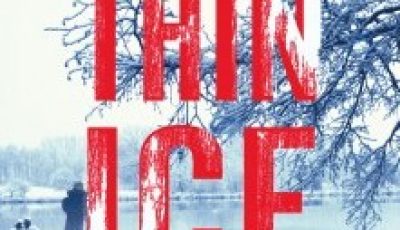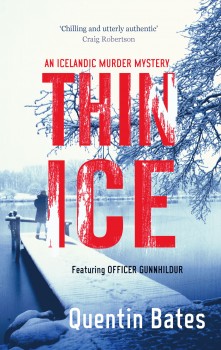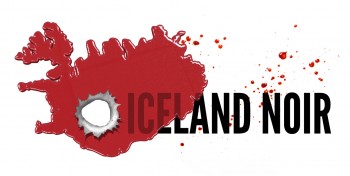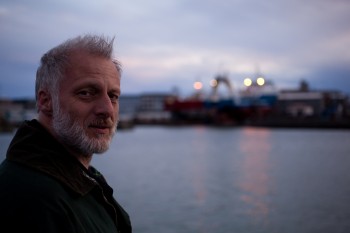

International Thrills: Interview with Quentin Bates
Iceland and the New Nordic Noir
 By J.F.Penn
By J.F.Penn
British author Quentin Bates spent 10 years in Iceland and now sets his bestselling Gunnhildur crime thrillers there. His latest book, Thin Ice, is out in March 2016.
USA Today bestselling thriller author J.F.Penn interviewed Quentin Bates for The Big Thrill.
First of all, tell us a bit about you and your background.
I went to Iceland for a gap year, which turned into a gap decade as I stayed in Iceland for ten years before finally moving back to England. For a lot of the time I worked on a trawlers, normally at sea for three weeks at a time. I had different jobs: as a deckhand, a net man, occasionally cook, mate, second mate. Being a ship’s cook was definitely the worst job as there’s always someone in even a small crew who complains the gravy isn’t like his mother makes.
Then I drifted into specialised trade journalism, writing for a maritime trade magazines. I did that as a freelance for a while, alongside other things. So, there was a gradual changeover before I finally hung up my oilskins, and then for fifteen years there was a staff job, mainly writing technical features and news material.
I did a university writing course, partly as a way of getting an afternoon off once a week to sit in a warn classroom, and that was where the possibilities of crime fiction stated to look increasingly tempting. This was before Stieg Larsson and The Girl with the Dragon Tattoo, so Nordic crime hadn’t really taken off at all. This was all still fairly niche. Wallander was around and before that had been Miss Smilla’s Feeling for Snow, and long before that were the Sjöwall and Wahlöö books from Sweden that I had read as a teenager in the 1970s.
How does your love for Iceland come through in the Gunnhildur series?
I shied away from using Iceland as a setting at first, because it seemed too close to home. But I gradually realized that I had all this knowledge, insight and understanding of the place and it would be ridiculous not to use it.
The main character popped up more or less from nowhere, although she wasn’t the original main character. The first draft of what eventually became the first book had a male protagonist, but he was dull. Too much of a bunch of clichés rolled together – the grumpy, middle-aged chap and all the rest of it. So he was quietly removed and his more interesting sidekick was promoted to the lead role. She seems to have done well enough so far, even though I give her a hard time. She’s still solving crimes way beyond her pay scale.
The first book was set in a fictional coastal village, a very loosely disguised version of a real fishing village on the south coast, within striking distance of Reykjavik so I could use both the coastal/rural backdrop as well as a city setting. The later books are set firmly in Reykjavik, but the new one, Thin Ice, takes place partly in the countryside north of the city.
I have purposely not used too many of the places that tourists would go to when they visit Iceland, the Golden Circle, Gullfoss and Geysir, and the Blue Lagoon and all the places like that. I’ve steered clear of those because I feel they give the feel of having been written by someone who might have done the research with a five-day package tour. In any case, these aren’t places that locals visit regularly.
So I’ve stuck to places that I know best – the suburbs and outlying areas of Reykjavik, rather than the centre of the city itself. Visitors to Iceland tend to see the 101 district, which is the central postal district of Reykjavik, the city center. It’s where all the bars, the galleries and the nightclubs are, and where the hipsters hang out – all the coffee shops and tourist trap shops. The rest of the place is very different.
There’s a huge difference between 101 and the rest of the sprawling city, and there’s a huge difference between the greater Reykjavik area and the rest of the country. Attitudes are different in the countryside, the pace of life is more relaxed, people will speak to you differently, and they’ll be more suspicious, or even more open. English is heard less frequently outside the city, although most people will speak English.
So the locations I’ve used tend to be around harbors and industrial estates, and unsmart bars and cafés, that kind of place. Essentially, the places that I’m most familiar with, and I don’t normally venture all that much into Reykjavik 101.
It’s dark for a lot of the day in the Icelandic winter and that must affect people’s personalities. Tell us a bit about living there, and the cycles of light and darkness.
The middle of winter, that’s the time of year that’s known as “skammdegi” – short day, is December, January, February. And it is dark, especially in the north of Iceland, where I lived. It gets light at 10:00 in the morning. It will be dark again soon after 3:00. The sun doesn’t come up over the horizon, even if you could see the horizon. It’s more like a long twilight, a little bit of day, and then a long twilight into darkness.
It does affect you. Some people get gloomy at that time of year. Some people get quite badly depressed and withdrawn. The years I lived there, it didn’t worry me a huge amount, partly because I was at sea much of the time, and ship’s time is different anyway. You work mainly six-on-six-off shifts, so you might be awake from 6am to midday and again from 6pm to midnight – or midnight to six and midday to six. So your body clock’s screwed up anyway, and it took me years to adjust back to normal waking hours.
What affected me more was the summertime, because it’s light all the time. It can be a nightmare getting to sleep because it doesn’t get dark and there can be a dawn chorus at 3am. I used to cut up bin bags and tape them over the windows, and hang blankets over windows so I could get proper darkness. So, for me, certainly, the summer was more of a challenge than the winter.
One of my books, Summerchill, is actually set in the height of summer. That was partly because I heard a well-known commentator commenting flippantly that, “Oh, all this Nordic crime happens in the dead of winter.” Which isn’t true, because there are quite a few that are set in the height of summer, especially some of the Sjöwall and Wahlöö books, which are set in those really hot Stockholm summers. So I thought I’d write a summer one as well.
The book takes place at the very hottest part of August. It’s sunny, it’s dusty because it hasn’t rained for weeks, and you know that winter’s just around the corner. The air feels heavy, with the first storm brewing over the Atlantic and it will be on you soon. So those are the last hot days of summer that everybody enjoys before it’s all over and once that first autumn storm has broken, winter is on the way.
What distinguishes Nordic crime as a genre, apart from the fact that it’s set in these northern countries?
It’s crime fiction, and it happens to be set in a particular set of locations. It’s very difficult to delineate Nordic crime per se, because Icelandic is very different to Finnish, it’s different to Norwegian.
People look at the Nordic nations and they see this homogeneous, blonde, blue-eyed mass, and they just assume that it’s all the same. It’s absolutely not. Denmark is very different from Iceland. Iceland’s very different from Norway. Norway’s very different from Finland. They all have their own quirks, tics and foibles, their own styles and their own preferences.
Iceland, in particular, is different because it’s an island. It’s miles from anywhere. It’s a volcanic rock in the middle of the North Atlantic, and for centuries it was almost completely isolated. From the end of the Viking era to the 19th century, virtually nobody ever went there, so the place was largely cut off. There was minimal contact with the rest of the world, with the kings of Norway and Denmark, who actually ruled it then. Iceland lost its independence at the end of the Sturlunga era in the 13th century and was ruled by the kings of Norway and then Denmark, although neither took a great deal of interest in this rocky island.
Iceland became independent in the 20th century, like so many other places. This has something of a hangover and the ex-colonial mentality is quite strong. I’m not sure my Icelandic friends would thank me for saying so, but it does give them a robustness that you maybe wouldn’t get in other countries. There’s a strong frontier mentality, particularly outside Reykjavik, partly because it’s so far from anywhere and I guess partly because of the determination to do things for yourself. Some parts of Iceland are really very remote, although much less remote than when I lived there back when there was no email or mobile phones. You couldn’t just go and get what you need, because it has to be sent or shipped, so people have a tradition of fixing things for themselves.
So there’s this independent, feisty, dark, very dry gallows humor, a frontier spirit that you also see in parts of Norway. Whereas Sweden and Denmark tend to be very different. Those are the more cosmopolitan nations much closer to the centre of Europe with very long traditions of trading and exchanging information and culture, as well as fighting endless wars with their neighbours.
There are some other Icelandic noir authors I would recommend, although there are only a few in English. There’s Arnaldur Indriðason and Yrsa Sigurðardóttir. Everybody seems to know them fairly well. There’s Ragnar Jónasson, who’s my translatee, who’ll obviously become a major star. There’s Viktor Arnar Ingólfsson, who has a couple of books in English, and Árni Thórarinsson, who unfortunately has only one. They’re all worth checking out. They’re all very different, with varying styles and emphases, very different approaches to what they do. If I were to pick just one for people to try, it would be Jar City by Arnaldur Indriðason. It gets under the skin of Iceland so brilliantly, especially the seedy, underworld side, and the movie of the book is also outstandingly good.
What are the themes and ideas that you keep coming back to in your writing?
Bad people doing bad things, but there has to be a reason for it. I don’t do serial killers. I know how popular they are and how controversial they are, but I haven’t been able to bring myself to do a serial killer yet and I’m not sure that I ever will. Serial killers don’t happen in Iceland. There was one, but he was executed in 1596. Serial killers are extraordinarily rare anywhere. They’re so rare that placing one in Iceland would be stretching probability way too far.
So, I like to have a crime to kick off a story and it generally has to be about money. Somewhere, somebody’s trying to rip someone else off. I seem to have a lot of corrupt politicians and officials in my books, and hadn’t actually noticed how many there were until someone pointed that out to me. But there are no bent politicians in the new book, so that’s something of a departure for me.
Thin Ice comes out in March. Two fairly inept criminals rob another criminal and their real problem is to get away with the money. Iceland is an island, and there are not very many ways out. There’s one airport. There’s one ferry port, and the only practical way out is through one of those two.
It’s a heist, something that’s very difficult to do in Iceland, because you can’t get away with money. If you rob a bank, you’ve got a bag full of Icelandic krónur that you can’t change into anything else even if you could get out of the country to start with. These two bad guys manage to rob a drugs kingpin of his stash of foreign currency, so that’s one of the two challenges out of the way. Their other challenges, after their escape route to the sunshine is suddenly cut off, is to stay alive and get out of the country, preferably with the bag of money. So they and the people they carjack to get away are being searched for by both Gunnhildur and her team, and also by the underworld.
It becomes kind of a “locked room” mystery, because it’s such a small place. It’s an island with 330,000 people, so practically any crime story set there is going to become a locked room mystery on a greater or lesser scale.
You’re also a translator for Ragnar Jónasson’s books, Snowblind and Nightblind.
Yes, I didn’t set out to be a translator but Orenda Books gave me the opportunity and I’m embracing it in order to bring some great Icelandic work to English. There are five of books in Ragnar’s series. I’m working on the fourth one now, and hoping that a few more Icelandic writers will start to appear in English, such as Lilja Sigurðardóttir, Jónína Leósdóttir and Ævar Örn Jósepsson.
Translation calls for some of the same skills as writing, and also different sets of skills. There’s no plotting to worry about, because someone else has already done all the heavy lifting. But, you have to interpret. It’s interpretation as much as translation.
I’ve done a lot of news and technical translation in the past, which is fairly straightforward, bare bones, and you have to convey the meaning precisely of what’s on the page. But with literary translation it tends to be a different because there are so many nooks and crannies that you have to dig into to get the right feel.
It’s about the feel as much as the meaning. Idioms, jokes and swearing can’t be translated directly, so you either have to find a way around them or find a substitute. Especially when there’s a joke or a play on words, there’s a choice between either keeping the precise meaning and losing the joke, or deviating from the original and keeping the joke – that’s what I mean about feel and meaning. There’s a joke in Blackout that I’ve managed to find a way around that I know a translator into another language just left out. I know Ragnar’s also keen to know what I’ve done with it, but the manuscript is at the edit stage at the moment and he’ll have to wait a little while before he gets to see it.
There words in Icelandic that we just don’t have in English. My favorite is “frekja”. It’s a unique blend of awkwardness, bloody-mindedness and pushiness, that we don’t have a proper word for, which perhaps says something about our national character.
 You’re also part of a festival called Iceland Noir. Tell us about that.
You’re also part of a festival called Iceland Noir. Tell us about that.
Iceland Noir was born over a curry and a beer, which is where the best ideas generally tend to come from. Ragnar Jónasson and Yrsa Sigurðardóttir and I were complaining among ourselves about the fact that there was no crime fiction festival in Iceland. And that’s as far as it went. A few weeks later, we met again, and it seemed that we had all been thinking along similar lines as we decided that we were going to have to do it ourselves. That was in 2013, then again in 2014. We took a break in 2015 and Shetland borrowed the date. It’s a very small festival, as it’s limited by the size of the Nordic House in Reykjavík, so it’s quite compact and it’s run on something of a shoestring. We keep the costs as low as we can and the aims are to have a good time for a few days with a bunch of criminally-minded people, and to not make a loss on it.
We plan to hold Iceland Noir every second year now, with an alternative location in the off years. Shetland was in 2015 and in 2017 it looks like Hull, which is a European city of culture for that year. We’re holding Iceland Noir this year, November 17 – 20, 2016 in Reykjavik and everything is in English. Details are at www.IcelandNoir.com and we have an all-female line-up of featured authors including Val McDermid, Leena Lehtolainen, Viveca Sten and Sara Blaedel.
Is there any chance of seeing the Northern Lights at that time of year?
It’s difficult to predict these wild phenomena, in fact, everything at that time of year is difficult to predict. It could be warm, it could be freezing, it could be snowing hard. One year, we should have had an opportunity to see the lights, because the conditions were absolutely perfect. There was cold still weather, there wasn’t a cloud in the sky. It was bitter cold, which is perfect Northern Lights conditions, but they just wouldn’t show up.
Then again, I’ve seen fantastic Northern Lights at times when they shouldn’t be there. I’ve seen them at the height of summer, on a late summer night, when it’s warm and damp, which shouldn’t happen. So they’re quite unpredictable but fantastic if you see them. You have to be a little bit patient, and you have to stand there in the cold, while they turn into something. But once you get a good show, then they’re unforgettable.
Where can people find you and your books online?
My website is www.graskeggur.com, which means greybeard. My name is awkward because there’s no Q in Icelandic. The letters Q, C, and Z, in theory, don’t exist, which is unfortunate when you’ve got a daft name like mine. So for the website and my twitter handle I adopted the nickname my wife’s grandmother gave me, Gráskeggur.
The Gunnhildur series is available on Amazon and all online bookstores, and the new book, Thin Ice, is out on 3rd March 2016.
*****
 J. F. Penn is a New York Times and USA Today Bestselling Author of thrillers with a supernatural edge. Oxford educated, British born, she has traveled the world in her study of religion and psychology. She brings these obsessions as well as a love for thrillers and an interest in the supernatural to her writing. Her fast-paced ARKANE thrillers weave together historical artifacts, global locations, a kick-ass protagonist and a hint of the supernatural.
J. F. Penn is a New York Times and USA Today Bestselling Author of thrillers with a supernatural edge. Oxford educated, British born, she has traveled the world in her study of religion and psychology. She brings these obsessions as well as a love for thrillers and an interest in the supernatural to her writing. Her fast-paced ARKANE thrillers weave together historical artifacts, global locations, a kick-ass protagonist and a hint of the supernatural.
To learn more, please visit her website.
- Africa Scene: Iris Mwanza by Michael Sears - December 16, 2024
- Late Checkout by Alan Orloff (VIDEO) - December 11, 2024
- Jack Stewart with Millie Naylor Hast (VIDEO) - December 11, 2024

